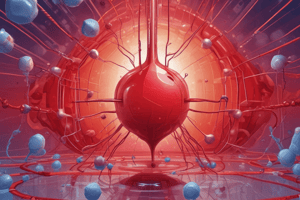Podcast
Questions and Answers
Who successfully performed the first blood transfusion?
Who successfully performed the first blood transfusion?
- Albert Hustin
- Edward E. Lindemann (correct)
- Francis Rous
- Lewisohn
The use of sodium citrate as an anticoagulant solution for transfusions was first reported in 1915.
The use of sodium citrate as an anticoagulant solution for transfusions was first reported in 1915.
False (B)
What was the primary factor driving blood preservation research during World War II?
What was the primary factor driving blood preservation research during World War II?
The increased demand for blood and plasma due to the war.
The Rh blood group system was discovered by Karl Landsteiner, Alex Wiener, Philip Levine, and ______.
The Rh blood group system was discovered by Karl Landsteiner, Alex Wiener, Philip Levine, and ______.
Match the following blood group systems with the years they were discovered:
Match the following blood group systems with the years they were discovered:
Which of the following was NOT a component of the US blood collection system in the 1940s?
Which of the following was NOT a component of the US blood collection system in the 1940s?
The preservative solution ACD was introduced in 1945.
The preservative solution ACD was introduced in 1945.
What was the main advantage of the plastic bag for blood collection introduced in 1949?
What was the main advantage of the plastic bag for blood collection introduced in 1949?
The maximum blood capacity of a 110-pound individual is up to ______ mL blood bag volume.
The maximum blood capacity of a 110-pound individual is up to ______ mL blood bag volume.
Which blood bag type allows separation into red cells, platelet concentrate, cryoprecipitate, and plasma?
Which blood bag type allows separation into red cells, platelet concentrate, cryoprecipitate, and plasma?
Flashcards
First Blood Transfusion
First Blood Transfusion
Performed by Edward E. Lindemann in 1913 using multiple syringes.
Sodium Citrate as Anticoagulant
Sodium Citrate as Anticoagulant
Reported by Albert Hustin in 1914 for blood transfusions.
Lewisohn's Contribution
Lewisohn's Contribution
Determined minimum citrate for anticoagulation; noted side effects.
Citrate-Dextrose Solution
Citrate-Dextrose Solution
Signup and view all the flashcards
First Hospital Blood Bank
First Hospital Blood Bank
Signup and view all the flashcards
Rh Blood Group Discovery
Rh Blood Group Discovery
Signup and view all the flashcards
Cold Ethanol Fractionation
Cold Ethanol Fractionation
Signup and view all the flashcards
Coombs Test
Coombs Test
Signup and view all the flashcards
Types of Blood Bags
Types of Blood Bags
Signup and view all the flashcards
Glycerol Cryoprotectant
Glycerol Cryoprotectant
Signup and view all the flashcards
Study Notes
Week 2: Introduction to Immunohematology
- 1913: Edward Lindemann first successfully performed blood transfusions.
- 1914: Albert Hustin introduced sodium citrate as an anticoagulant for transfusions.
- 1915: Lewisohn determined the minimum amount of citrate for safe anticoagulation, demonstrating its nontoxicity. Massive transfusions now dependent on blood. Citrate toxicity levels decreased.
- 1916: Development of preservative solutions to enhance red blood cell metabolism introduced for blood preservation. Francis Rous and Turner introduced citrate-dextrose solution.
- 1927-1947: Discovery of the MNSs and P blood group systems. Improved understanding of the RBC membrane, its metabolism, and permeability.
- 1930s: Improved understanding of RBC membrane properties, important for preventing reactions.
- 1932: First hospital-based blood depot established in Leningrad.
- 1937: Bernard Fantus established the first hospital blood bank in the US at Cook County Hospital. Fantus popularized the term "blood bank".
- 1939-1945 (World War II): Increased demand for blood preservation.
- 1939-1940: Discovery of the Rh blood group system by Landsteiner, Wiener, Levine, and Stetson.
- 1940: Medical School process for breaking down plasma into components including albumin, gamma globulin, and fibrinogen.
- 1941: Dr. Charles Drew appointed director of the first American Red Cross Blood Bank.
- 1943: Loutit and Mollison formulated a blood formula. First blood container (vacuum bottle/vacutainer tube).
- 1945: Development of the preservative acid-citrate-dextrose (ACD). Coombs, Mourant, and Race, introduced use of antihuman globulin ("Coombs Test") to identify incomplete or unknown antibodies. AABB (American Association of Blood Banks) formed to promote blood banking practices.
- 1947: Publication of the Journal of Clinical Investigation and guideline book. Blood banks established nationwide.
- 1949-1950: The US blood collection system includes hospital blood banks, community blood centers and the American Red Cross regional blood centers. Audrey Smith researched glycerol cryoprotectant for freezing red blood cells, and its use alongside glucose and urea to prevent water loss.
- 1950: Carl Walter and W.P. Murphy introduced plastic bags for blood component collection from single units.
- Blood Bag Information: Different types of blood bags (single, double, triple, quadruple) described and their use in separating whole blood components.
Blood Bags
- Whole blood: 450-500 mL with 63-70 mL of anticoagulant.
- Maximum Capacity (110-pound individual): 525 mL.
- Different Bag Types: Used for separating whole blood into various components including red blood cells, plasma, platelets, and cryoprecipitate.
Studying That Suits You
Use AI to generate personalized quizzes and flashcards to suit your learning preferences.




